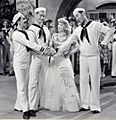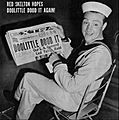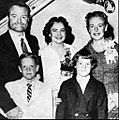Red Skelton facts for kids
Quick facts for kids
Red Skelton
|
|
|---|---|

Skelton in 1960
|
|
| Born |
Richard Red Skelton
July 18, 1913 Vincennes, Indiana, U.S.
|
| Died | September 17, 1997 (aged 84) |
| Resting place | Forest Lawn Memorial Park, Glendale, California, U.S. |
| Occupation | Actor, artist, comedian |
| Years active | 1923–1993 |
| Spouse(s) |
Edna Marie Stillwell
(m. 1931; div. 1943)Georgia Davis
(m. 1945; div. 1971)Lothian Toland
(m. 1973) |
| Children | 2 |
Richard Red Skelton (July 18, 1913 – September 17, 1997) was an American entertainer best known for his national radio and television shows between 1937 and 1971, especially as host of the television program The Red Skelton Show. He has stars on the Hollywood Walk of Fame for his work in radio and television, and also appeared in burlesque, vaudeville, films, nightclubs, and casinos, all while he pursued an entirely separate career as an artist.
Skelton began developing his comedic and pantomime skills from the age of 10, when he became part of a traveling medicine show. He then spent time on a showboat, worked the burlesque circuit, and then entered into vaudeville in 1934. The "Doughnut Dunkers" pantomime sketch, which he wrote together with his wife, launched a career for him in vaudeville, radio, and films. His radio career began in 1937 with a guest appearance on The Fleischmann's Yeast Hour, which led to his becoming the host of Avalon Time in 1938. He became the host of The Raleigh Cigarette Program in 1941, on which many of his comedy characters were created, and he had a regularly scheduled radio program until 1957. Skelton made his film debut in 1938 alongside Ginger Rogers and Douglas Fairbanks Jr. in Alfred Santell's Having Wonderful Time, and would appear in numerous musical and comedy films throughout the 1940s and 1950s, with starring roles in 19 films, including Ship Ahoy (1941), I Dood It (1943), Ziegfeld Follies (1946), and The Clown (1953).
Skelton was eager to work in television, even when the medium was in its infancy. The Red Skelton Show made its television premiere on September 30, 1951, on NBC. By 1954, Skelton's program moved to CBS, where it was expanded to one hour and renamed The Red Skelton Hour in 1962. Despite high ratings, the show was canceled by CBS in 1970, as the network believed that more youth-oriented programs were needed to attract younger viewers and their spending power. Skelton moved his program to NBC, where he completed his last year with a regularly scheduled television show in 1971. He spent his time after that making as many as 125 personal appearances a year and working on his paintings.
Skelton's paintings of clowns remained a hobby until 1964, when his wife Georgia persuaded him to show them at the Sands Hotel in Las Vegas while he was performing there. Sales of his originals were successful, and he also sold prints and lithographs, earning $2.5 million yearly on lithograph sales. At the time of his death, his art dealer said he thought that Skelton had earned more money through his paintings than from his television performances.
Skelton believed that his life's work was to make people laugh; he wanted to be known as a clown because he defined it as being able to do everything. He had a 70-year-long career as a performer and entertained three generations of Americans. His widow donated many of his personal and professional effects to Vincennes University, including prints of his artwork. They are part of the Red Skelton Museum of American Comedy at Vincennes, Indiana.
Contents
Awards and recognition
In 1952, Skelton received Emmy Awards for Best Comedy Program and Best Comedian. He also received an Emmy nomination in 1957 for his noncomedic performance in Playhouse 90's presentation of "The Big Slide". Skelton and his writers won another Emmy in 1961 for Outstanding Writing Achievement in Comedy. He was named an honorary faculty member of Ringling Bros. and Barnum & Bailey Clown College in 1968 and 1969.
Skelton's first major post-television recognition came in 1978, when the Golden Globe Awards named him as the recipient for their Cecil B. DeMille Award, which is given to honor outstanding contributions in entertainment. His excitement was so great upon receiving the award and a standing ovation, that he clutched it tightly enough to break the statuette. When he was presented with the Academy of Television Arts & Sciences' Governor's Award in 1986, Skelton received a standing ovation. "I want to thank you for sitting down", he said when the ovation subsided. "I thought you were pulling a CBS and walking out on me." The honor came 16 years after his television program left the airwaves.
Skelton received a Lifetime Achievement Award from the Screen Actors Guild in 1987, and in 1988, he was inducted into the Academy of Television Arts & Sciences' Television Hall of Fame. He was one of the International Clown Hall of Fame's first inductees in 1989. Skelton and Katharine Hepburn were honored with lifetime achievement awards by the American Comedy Awards in the same year. He was inducted into the National Radio Hall of Fame in 1994. Skelton also has two stars on the Hollywood Walk of Fame for his radio and television work.
Legacy and tributes
Skelton preferred to be described as a clown rather than a comic: "A comedian goes out and hits people right on. A clown uses pathos. He can be funny, then turn right around and reach people and touch them with what life is like." "I just want to be known as a clown", he said, "because to me that's the height of my profession. It means you can do everything—sing, dance and above all, make people laugh." His purpose in life, he believed, was to make people laugh.
In Groucho and Me, Groucho Marx called Skelton "the most unacclaimed clown in show business", and "the logical successor to [Charlie] Chaplin", largely because of his ability to play a multitude of characters with minimal use of dialogue and props. He added that Skelton also "plays a dramatic scene about as effectively as any of the dramatic actors." In late 1965, ventriloquist Edgar Bergen, reminiscing about the entertainment business, singled out Skelton for high praise. "It's all so very different today. The whole business of comedy has changed — from 15 minutes of quality to quantity. We had a lot of very funny people around, from Charley Chase to Charlie Chaplin and Laurel and Hardy. The last one of that breed is Red Skelton." Harry Cohn of Columbia Pictures also praised Skelton, saying, "He's a clown in the old tradition. He doesn't need punch lines. He's got heart."
The Red Skelton Performing Arts Center was dedicated in February 2006 on the campus of Vincennes University, one block from the home in Vincennes where Skelton was born. The building includes an 850-seat theater, classrooms, rehearsal rooms, and dressing rooms. Its grand foyer is a gallery for Skelton's paintings, statues, and film posters. The theater hosts theatrical and musical productions by Vincennes University, as well as special events, convocations, and conventions. The adjacent Red Skelton Museum of American Comedy opened on July 18, 2013, on what would have been Skelton's 100th birthday. It houses his personal and professional materials, which he had collected since the age of 10, in accordance with his wishes that they be made available in his hometown for the public's enjoyment. Skelton's widow, Lothian, noted that he expressed no interest in any sort of Hollywood memorial. The museum is funded jointly by the Red Skelton Museum Foundation and the Indiana Historical Society. Other foundation projects include a fund that provides new clothes to Vincennes children from low-income families. The foundation also purchased Skelton's birthplace. On July 15, 2017, the state of Indiana unveiled a state historic marker at the home in Vincennes where Skelton was born.
The town of Vincennes has held an annual Red Skelton Festival since 2005. A "Parade of a Thousand Clowns", billed as the largest clown parade in the Midwest, is followed by family-oriented activities and live music performances.
List of characters
Here is a list of several characters that Red Skelton created:
- Clem Kadiddlehopper
- Freddie the Freeloader
- Gertrude and Heathcliffe
- Sheriff Deadeye
- Cauliflower McPugg
- George Appleby
- San Fernando Red
- Willie Lump Lump
- Junior the Mean Widdle Kid
- Bolivar Shagnasty
Filmography
Features
- Dead End (1937) as paramedic/doctor (uncredited)
- Having Wonderful Time (1938) as Itchy
- Flight Command (1940) as Lieut. 'Mugger' Martin
- The People vs. Dr. Kildare (1941) as Vernon Briggs
- Whistling in the Dark (1941) as Wally Benton
- Dr. Kildare's Wedding Day (1941) as Vernon Briggs
- Lady Be Good (1941) as Joe 'Red' Willet
- Ship Ahoy (1942) as Merton K. Kibble
- Maisie Gets Her Man (1942) as 'Hap' Hixby
- Panama Hattie (1942) as Red
- Whistling in Dixie (1942) as Wally 'The Fox' Benton
- Du Barry Was a Lady (1943) as Louis Blore / King Louis XV
- I Dood It (1943) as Joseph Rivington Renolds
- Thousands Cheer (1943) as Red Skelton
- Whistling in Brooklyn (1943) as Wally 'The Fox' Benton
- Bathing Beauty (1944) as Steve Elliot
- Ziegfeld Follies (1946) as J. Newton Numbskull ('When Television Comes')
- The Show-Off (1946) as J. Aubrey Piper
- Merton of the Movies (1947) as Merton Gill aka Clifford Armytage
- The Fuller Brush Man (1948) as Red Jones
- A Southern Yankee (1948) as Aubrey Filmore
- Neptune's Daughter (1949) as Jack Spratt
- The Yellow Cab Man (1950) as Augustus 'Red' Pirdy
- Three Little Words (1950) as Harry Ruby
- Duchess of Idaho (1950) as Himself (uncredited)
- The Fuller Brush Girl (1950, cameo) as Himself – Fuller Brush Man (uncredited)
- Watch the Birdie (1950) as Rusty Cammeron / Pop Cammeron / Grandpop Cammeron
- Excuse My Dust (1951) as Joe Belden
- Texas Carnival (1951) as Cornie Quinell
- Lovely to Look At (1952) as Al Marsh
- The Clown (1953) as Dodo Delwyn
- Half a Hero (1953) as Ben Dobson
- The Great Diamond Robbery (1954) as Ambrose C. Park
- Susan Slept Here (1954, cameo) as Oswald from North Dakota (uncredited)
- Around the World in 80 Days (1956, cameo)
- Public Pigeon No. 1 (1957) as Rusty Morgan
- Ocean's 11 (1960, cameo) as Gambler
- Those Magnificent Men in Their Flying Machines (1965) as The Neanderthal Man / Passenger on Airport
- Rudolph's Shiny New Year (1976) as Father Time and Baby Bear (voice role)
- Red Skelton's Christmas Dinner (1981)
Short subjects
- The Broadway Buckaroo (1939) as Red
- Seeing Red (1939) as Red / Doorman / Coatroom Attendant / Waiter / Emcee
- Radio Bugs (1944) as Red Skelton (voice, uncredited)
- Weekend in Hollywood (1947)
- The Luckiest Guy in the World (1947, voice)
- Some of the Best (1949)
Box-office ranking
Based on rankings of the amount of money earned in box-office receipts for film showings, for a number of years Skelton was among the most popular stars in the country:
- 1944 – 16th-largest box-office draw
- 1949 – 13th
- 1951 – 14th
- 1952 – 21st
Images for kids
-
Skelton with John Garfield at the 1944 FDR Birthday Ball
-
Skelton with Ann Rutherford and Virginia Grey as radio detective "The Fox" in Whistling in the Dark (1941)
-
Skelton's imprint ceremony at Grauman's Chinese Theatre, June 18, 1942: His wife, Edna, is on his left. Skelton also imprinted "Junior's" shoes along with the message, "We Dood It!". Theater owner Sid Grauman is in foreground of photo.
-
Skelton as Willie Lump-Lump and Shirley Mitchell as his wife, who appears to be walking on the wall in a 1952 Skelton show sketch
-
Skelton as Freddie the Freeloader (right) and Terry-Thomas
-
Skelton performing with Marcel Marceau, 1965 – the two were friends for many years.
See also
 In Spanish: Red Skelton para niños
In Spanish: Red Skelton para niños
















